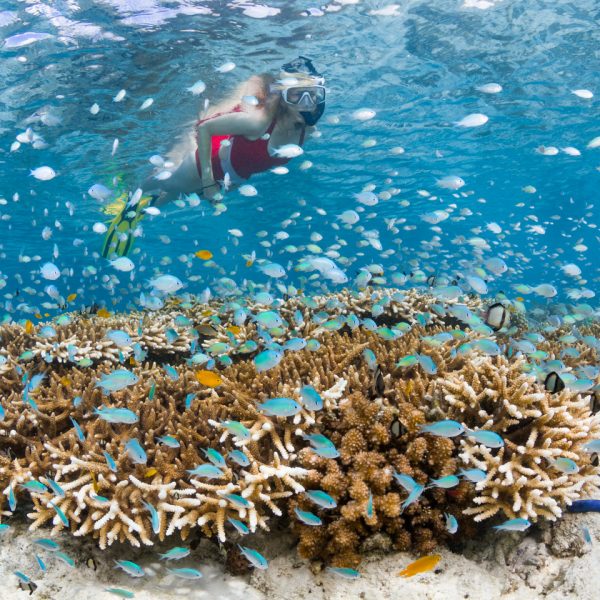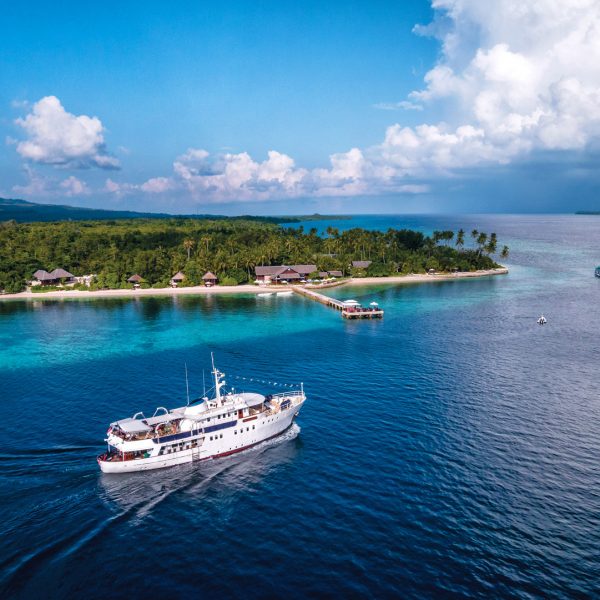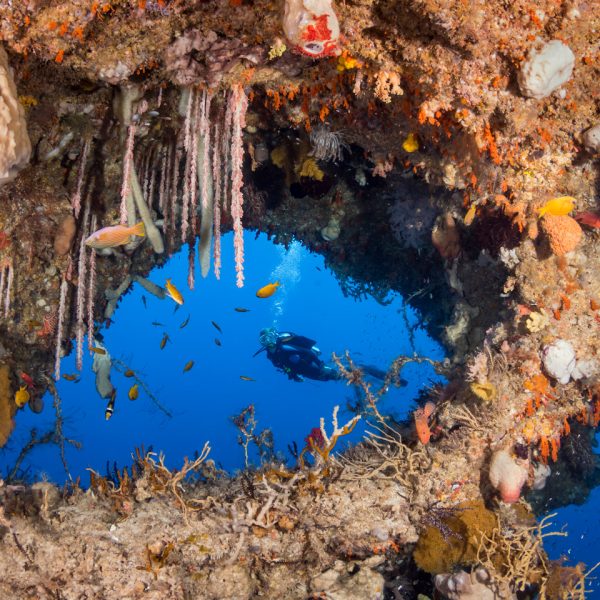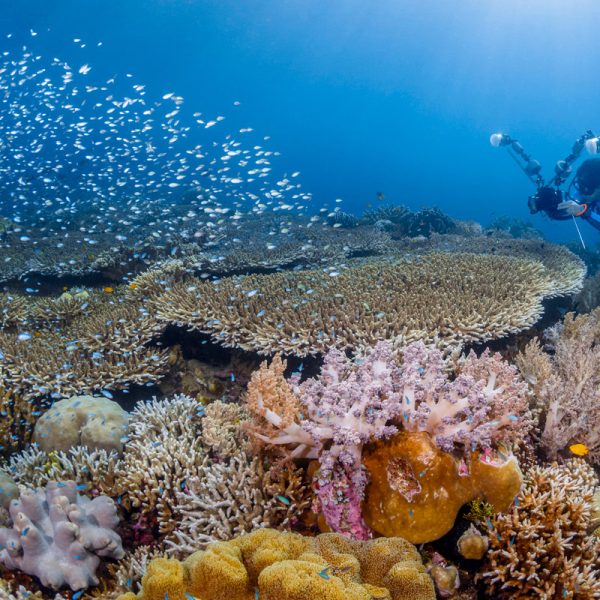The Pelagian is home based at Wakatobi Dive Resort, so you can expect the very same standards you trust from the resort. You’ll find spacious and elegant guest areas, outstanding amenities and the most incredible marine life to round off a vacation aboard Pelagian. Few (if any) liveaboards around the world, can boast the comfort and level of personalized attention found on Wakatobi’s premier live-aboard.
Accommodations
The newly remodeled Wakatobi dive yacht, Pelagian, is like a floating tropical boutique hotel with ever-changing topside and UW vistas. All of the cabins have been masterfully designed for comfort and aesthetics. Spacious floor plans, luxurious bathrooms and modern decor create relaxing environments for guests. Pelagian offers more space per guest than any dive yacht of its kind. All interior spaces are air conditioned and each cabin has its own temperature control. Guests enjoy an unlimited hot and cold water supply and fresh towels daily.
Master Suite
This beautiful master suite spans the full width of the vessel (and occupies the entire bow on main deck). It offers all the comforts of home and is the largest cabin available. A King Size bed (a rarity on liveaboards!) offers relaxing and restful sleep. A spacious lounge with a love seat provides the perfect place to watch videos on the HD flat screen TV with Blue ray, DVD player. Listen to music, read, or work on your laptop — in total privacy. The bathroom is contemporary and features top of the line rainforest shower and vanity fittings. The Master Suite is located conveniently at the center of the boat on the main deck level. That means quick access from any place on the yacht with no access staircase to ascend/descend.
Superlux Cabins #3 and #5
The Superlux cabins offer fresh, bright spa-like environments for guests. From the spacious floor plan, to the wall art and the smallest decor details, these cabins evoke a feeling of tranquility and restfulness. Both of these cabins feature a walk-around, queen-size bed and separate daybed. No need to climb over your partner in the middle of the night to reach the bathroom or in search for a drink! Hanging bedside tables and large drawers under the beds offer guests ample space to store personal items. Adjustable, high-intensity reading lights hang from the headboards for convenient night-time reading. Spaciousness extends into the beautiful bathrooms featuring a glass shower area, a big vanity with spa-like fixtures and great lighting. Both of these cabins are located forward of the main salon and down a flight of stairs. They both have several that let in ample daylight.
Deluxe Cabin
The efficient layout of the deluxe cabin creates the perfect accommodations for a couple or two dive buddies looking for their own space. This cabin features two beds; one wide enough for two people, the other accommodates one person. Built-in drawers and a small loveseat offers a place to sit, read, and maintain your dive log or work on your laptop. This cabin also has a newly-remodeled bathroom with shower and toilet. The popular Deluxe Cabin is located at the stern of the yacht, and has its own staircase accessed directly from the main salon.
Standard Cabin
The Standard Cabin is best for divers who tend to focus more on the boat’s common areas (and their diving) than on having the largest cabin onboard. This cabin features two single beds arranged opposite each other and built-in storage for stowing personal items. This cabin also has a newly-remodeled bathroom with shower and toilet and like all the other cabins, is air-conditioned with private control. This cabin is located on the starboard side of the ship from a separate staircase by the camera room. Perfect locale for the camera equipment tinkerer!
Dining
Onboard cuisine is prepared to the same high standard as that of the resort, as the chefs take turns between Pelagian and Wakatobi. The food served onboard is an international blend, combining Indonesian delicacies and flavors with dishes from around the world. If you have special dietary needs, the chefs will happily accommodate you. Whether it’s a food allergy or simply a preference, they are used to low-carb, vegetarian, low lactose or gluten free diets. They are pleased to accommodate but do require some advanced notice.
Diving
The Indo-Pacific region is considered a biodiversity hot spot, benefiting from the currents and nutrients transported between the Pacific and Indian Oceans. Within that area, the Wakatobi region is near the epicenter of coral reef biodiversity. The hundreds of kilometers of reef structure in the Wakatobi National Marine Park provide every imaginable marine animal, including whales, dolphins, sharks, rays, tunas, barracudas, marlin and more. The area is teeming with hundreds, if not thousands of different fish species. For instance, Les Kaufman, Professor of Biology at the Boston University Marine Program & Center for Ecology and Conservation Biology, counted 301 fish species on a 100 minute dive at Wakatobi Dive Resort’s house reef in 2004.
In general Pelagian dives different sites than those reached from Wakatobi resort. However, some sites near the resort are (due to their popularity) visited on the first and last diving day of a cruise. For photographers, this means wide-angle, normal and macro opportunities abound.
The Pelagian is well equipped for underwater photographers and videographers. You will find ample space to work on your camera, charge your batteries and store equipment.
Pelagian is fully equipped to cater to tech divers. They feature a Nitrox Technologies membrane system, Mattei low pressure compressors and Bauer high pressure compressors. They can also provide pure Oxygen as well as Helium for certified divers. Rebreather diving is also supported on Pelagian.
You can expect up to four dives daily on Pelagian; two morning, one afternoon and one dusk or night dive, weather conditions permitting.
Itineraries
There 7 night cruises offering 6 days of diving and allowing for up to 25 dives. There is also a 10 night itinerary offering 9 days of diving and allowing for up to 35 dives in your log book. A few of the dives you’d visit on both itineraries follow:
Cheeky Beach
Located in front of a local village, Pasar Wajo, this site is called cheeky beach on account of all the local children who crowd the surface holding onto anything keeping them afloat, as they “cheekily” observe the divers with noisy curiosity. This is a site that you can dive repetitively – each dive is different and critters come out depending on the time of day and lunar calendar. It is a shrimp breeding ground with the most rare and special shrimps found here in abundance, all in one area. Harlequin shrimp, Coleman shrimp, halimeda crabs to name a few of the impressive ones. Mostly a steep slope of round weathered stone and rock, moving mats of sea urchins creep steadily over the sand. Any coral outcrop is crawling with critters trying to stay out of site by day. There are frogfish and sea horses, invisible amongst the trash and broken bits of the villagers above water. Wonderpuss hunts warily, aware that while seeking prey it can become someone’s meal in an instant. Night dives bring out the bizarre – snake eels, spider crabs and goliath mantis shrimp and should never be missed. This is a 10 out of 10 muck dive!
Gone with the Wind
The name is appropriate since current here is almost always quite lively and sweeps the divers for a long drift. This place is just at the end of “Escape”, where the wall ends and turns into a coral garden (5-25m/15-75f depth) and continues deeper into a sandy plateau (30-35m/100-120f depth). Along this plateau, when currents are not too strong, it’s possible to linger and see eagle rays, white tips, schooling giant tunas, barracudas and jacks. After leaving the plateau the dive goes on first with the coral garden where lobsters, nudies, sea snakes, scorpionfish and lots more can be found, then with a less colorful wall that features turtles, schooling bumphead parrotfish and other fish. A great action dive.
Asphalt Pier
This site is located at the base of an old asphalt production plant. The surface is a mangle of rusting shacks and sacks of junk. It’s not pretty, but as you descend the rewards lie in wait. A sandy slope descends form four concrete pylons of the jetty and it is littered with large tires, barrels and abandoned fishing traps between 9 and 15m. Tucked in the nooks and crannies are ornate ghost pipe fish, garden eels, nudibranchs and pegasus moth fish. Blue ribbon eels, and frogfish are frequently seen here. Other special photo opportunities here are the gold-specs jawfish incubating large egg masses in their mouths, and if you are lucky you can observe them briefly spit them out to aerate them and then quickly suck them back to safety. If not busy reproducing, the jawfish must keep house, darting in and out of their burrows with mouthfuls of sand. Other rare sightings include the wonderpuss and a burrow with four yellow-nose shrimp gobies!
Conservation
The Pelagian is run by Wakatobi Dive Resort and for many years, Wakatobi has been known to be one of the world’s most proactive eco-tourism resorts and has won several awards for being the most conservation-minded tourism operator in the Asia-Pacific region. Wakatobi has worked together with Project AWARE to advise operators worldwide how to contribute substantially towards the marine ecosystem. Some of the ways they support conservation are by educating guests and implementing rules about the treatment of the reef. They clean 1 km of beach daily, and conduct reef monitoring and cleaning. They reduce, separate and recycle waste as much as possible. In addition to supporting local events, schools and villages, Wakatobi innovatively sponsored electricity for the 500-person village on their resort island (including 2 km power line to the village, transformers, electrical installations in every house, providing a 24 hrs maintenance team) in exchange for the villagers honoring a 3 km reef sanctuary on their traditional fishing grounds. Wakatobi also sponsors waste management in the surrounding villages on the neighboring island and sponsors public moorings and harbor facilities to reduce anchor damage. When you choose to stay with Wakatobi or sail with Pelagian, you are helping their conservation efforts.







